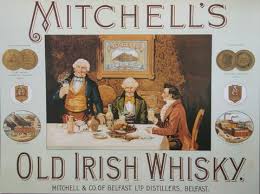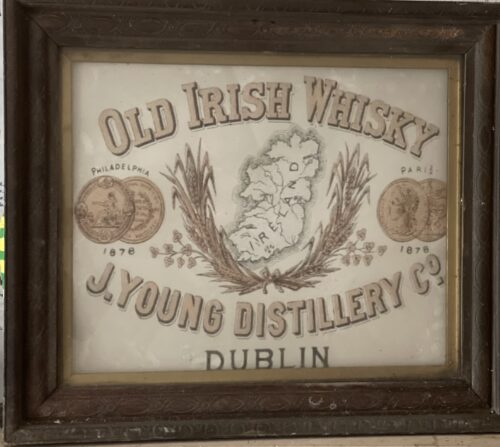-
Out of stock
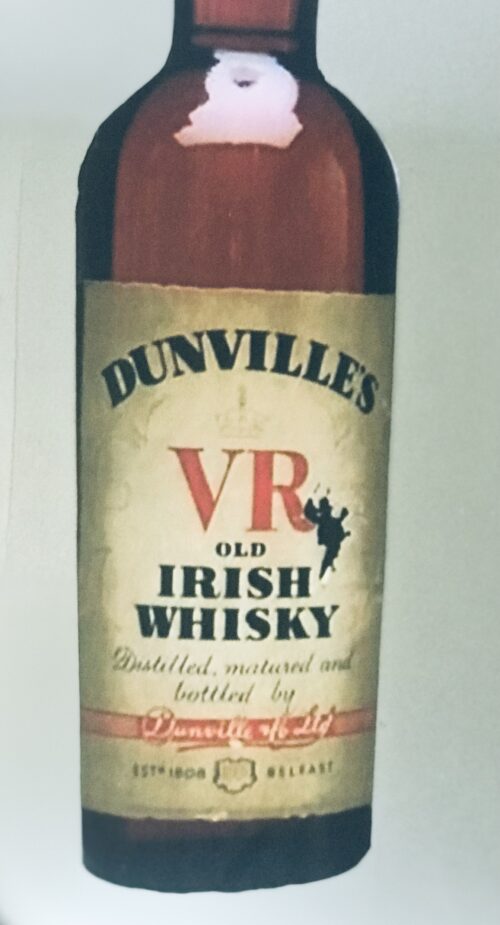
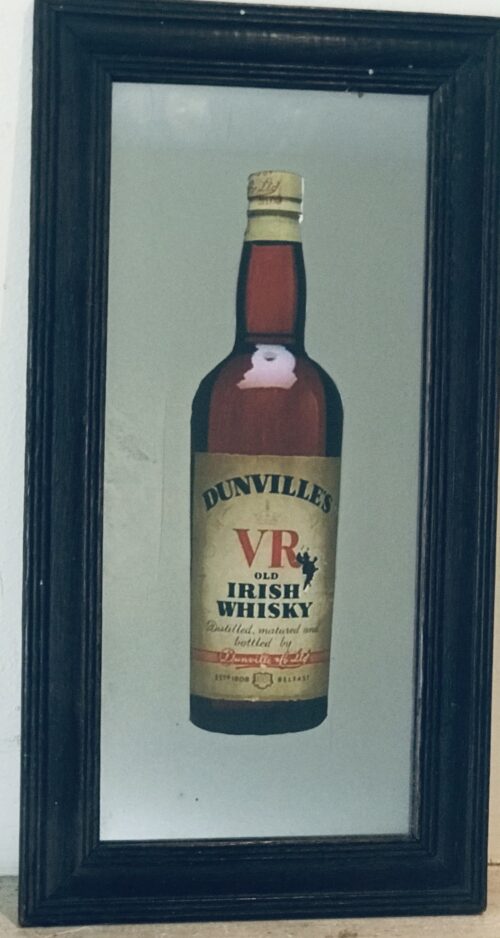 Nice little reproduced Dunvilles mirror. 40cm x 20cm Dunville & Co. was a tea and spirits merchant company, based in Belfast, County Antrim. The company initially gained success as an Irish whiskey blender, but later produced and marketed its own whiskey, having constructed its own distillery. The company was founded by John Dumvill who joined William Napier of Napier & Co. The spelling of Dumvill was changed to Dunville and in 1825 the company name became Dunville & Co. In 1837, Dunville began producing its most popular whisky Dunville's VR. Dunville's was the main brand name of Dunville & Co, and was used in advertisements, on pub windows and pub mirrors such as the beautiful example featured here on the irishpubemporium.com and on whisky dispensers, water jugs, trays, match strikers, ash trays and playing cards.Although Dunville & Co was established and based in Ireland, before the Partition of Ireland, and Irish whiskey is normally spelt with an 'e' in 'whiskey', Dunville's Whisky was always spelt without an 'e' in 'Whisky'.In 2013, almost 80 years after the last Dunville's was distilled, the Echlinville Distillery revived the Dunville's brand, and began distilling at their facility in the Ards Peninsula. Previously they had purchased spirits from other distillers and aged it themselves. Dunville's VR Old Irish Whiskey and Dunville's Three Crowns Irish Whiskey from The Echlinville Distillery came on the market in 2016. Having gained success as a whiskey blender, Dunville & Co. constructed their own distillery, the Royal Irish Distilleries, on the edge of Belfast in 1869. When built, the distillery occupied an impressive four-storey red-brick building, and was amongst the most modern in Ireland.With production from five pot stills, and later a Coffey still, at its peak the distillery had a capacity of over 2.5 million gallons per annum, making it amongst the largest in the country.Much of the distillery's output was used in the company's whiskey blends, Dunville's VR and Dunville's Three Crowns. Although, like other Irish distilleries, Prohibition caused Dunville to lose access to the important American market, Dunville ended the 1920s in good financial health. However, when the last heir and chairman of Dunville, Robert Lambart Dunville, died in 1931, the company began to flounder, and left to its directors, in 1936 Dunville & Co. was liquidated. Incredibly, and almost uniquely amongst the Irish distilleries that closed in the 20th century, liquidation was not forced upon the firm, as Dunville was actually still profitable when it was wound up.The main brand name of Dunville & Co. was used in advertisements, on pub windows and pub mirrors, and on whisky dispensers, water jugs, trays, match strikers, ash trays and playing cards. Although Dunville & Co was established and based in Ireland, before the Partition of Ireland, and Irish whiskey is normally spelt with an 'e' in 'whiskey', Dunville's Whisky was always spelt without an 'e' in 'Whisky'. In 2013, almost 80 years after the last Dunville's was distilled, the Echlinville Distillery revived the Dunville's brand, and began distilling at their facility in the Ards Peninsula. Previously they had purchased spirits from other distillers and aged it themselves. Dunville's VR Old Irish Whiskey and Dunville's Three Crowns Irish Whiskey from The Echlinville Distillery came on the market in 2016.
Nice little reproduced Dunvilles mirror. 40cm x 20cm Dunville & Co. was a tea and spirits merchant company, based in Belfast, County Antrim. The company initially gained success as an Irish whiskey blender, but later produced and marketed its own whiskey, having constructed its own distillery. The company was founded by John Dumvill who joined William Napier of Napier & Co. The spelling of Dumvill was changed to Dunville and in 1825 the company name became Dunville & Co. In 1837, Dunville began producing its most popular whisky Dunville's VR. Dunville's was the main brand name of Dunville & Co, and was used in advertisements, on pub windows and pub mirrors such as the beautiful example featured here on the irishpubemporium.com and on whisky dispensers, water jugs, trays, match strikers, ash trays and playing cards.Although Dunville & Co was established and based in Ireland, before the Partition of Ireland, and Irish whiskey is normally spelt with an 'e' in 'whiskey', Dunville's Whisky was always spelt without an 'e' in 'Whisky'.In 2013, almost 80 years after the last Dunville's was distilled, the Echlinville Distillery revived the Dunville's brand, and began distilling at their facility in the Ards Peninsula. Previously they had purchased spirits from other distillers and aged it themselves. Dunville's VR Old Irish Whiskey and Dunville's Three Crowns Irish Whiskey from The Echlinville Distillery came on the market in 2016. Having gained success as a whiskey blender, Dunville & Co. constructed their own distillery, the Royal Irish Distilleries, on the edge of Belfast in 1869. When built, the distillery occupied an impressive four-storey red-brick building, and was amongst the most modern in Ireland.With production from five pot stills, and later a Coffey still, at its peak the distillery had a capacity of over 2.5 million gallons per annum, making it amongst the largest in the country.Much of the distillery's output was used in the company's whiskey blends, Dunville's VR and Dunville's Three Crowns. Although, like other Irish distilleries, Prohibition caused Dunville to lose access to the important American market, Dunville ended the 1920s in good financial health. However, when the last heir and chairman of Dunville, Robert Lambart Dunville, died in 1931, the company began to flounder, and left to its directors, in 1936 Dunville & Co. was liquidated. Incredibly, and almost uniquely amongst the Irish distilleries that closed in the 20th century, liquidation was not forced upon the firm, as Dunville was actually still profitable when it was wound up.The main brand name of Dunville & Co. was used in advertisements, on pub windows and pub mirrors, and on whisky dispensers, water jugs, trays, match strikers, ash trays and playing cards. Although Dunville & Co was established and based in Ireland, before the Partition of Ireland, and Irish whiskey is normally spelt with an 'e' in 'whiskey', Dunville's Whisky was always spelt without an 'e' in 'Whisky'. In 2013, almost 80 years after the last Dunville's was distilled, the Echlinville Distillery revived the Dunville's brand, and began distilling at their facility in the Ards Peninsula. Previously they had purchased spirits from other distillers and aged it themselves. Dunville's VR Old Irish Whiskey and Dunville's Three Crowns Irish Whiskey from The Echlinville Distillery came on the market in 2016. -

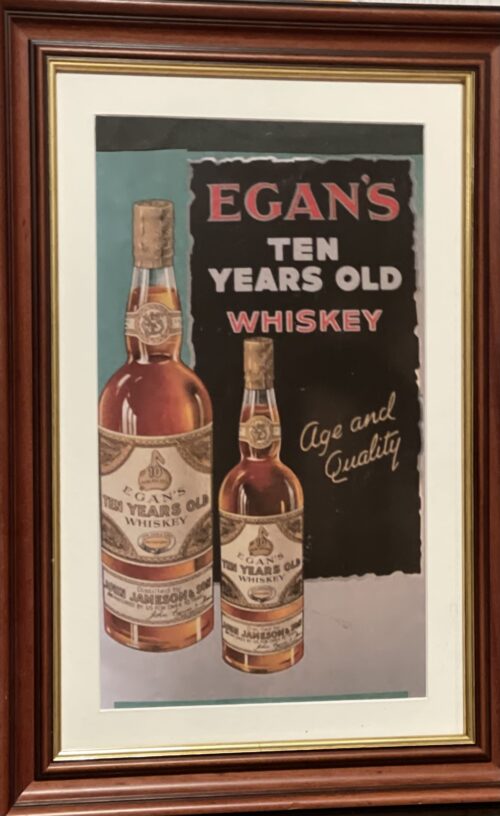 52cm x 44cm Patrick and Henry Egan are perhaps the two brothers whose names are most synonomous with the Tullamore business of P. & H. Egan Ltd. However it was Patrick and Henry’s father, Patrick Egan snr, who first established the business in 1852, and under whose name the company traded in the early years. Egan’s Bridge House, Tullamore, 1852-1968 Patrick Egan snr was born in 1805, the 3rd son of James Egan, a landholder and farmer from Tuarfelim near Moate in Co. Westmeath. Patrick studied law at the King’s Inns and, in 1834, when Daniel O’Connell attended a function to mark the opening of The National Bank in Moate, ‘a young Moate Solicitor named Patrick Egan read an address to O’Connell’. O’Connell would later use his considerable influence to have Egan appointed as the Crown Solicitor for Westmeath. In addition to his burgeoning legal practice, with offices in Moate and at 39 Nassau Street, Dublin, Patrick also set about establishing a number of businesses in Moate, Kilbeggan and Tullamore. The Moate enterprise was a prosperous hardware, grocery and spirit business, which traded as P. Egan & Sons, and was managed by Patrick’s sons William and Luke Egan. The Kilbeggan business was established around 1850 and traded for about thirty years as John Egan & Co. until 1884 when it was sold by P. & H. Egan. In the interim Patrick had also begun to establish himself in the commercial and political life of Tullamore where he was joined by his two eldest sons, Patrick jnr and Henry. Like their father both Patrick and Henry Egan were formidable businessmen whose energetic enterprise have left an indelible mark on the commercial, political and social history of Tullamore. In 1852 P. Egan & Sons began trading from their Bridge House premises as general merchants, provisions, and spirit dealers. The Bridge House business grew exponentially in the early years and by 1882, in addition to a dedicated smoking loft for Irish bacon, Patrick and Henry Egan were also importing bacon directly from America for the wholesale trade. In 1892 ‘the various departments include the choicest growths of teas, general groceries, provisions, Italian warehouse goods, and American and Colonial produce’. In 1866 Egan’s had also acquired an interest in the long established Tullamore Brewery owned by Richard Deverell and in 1869 P. Egan & Sons were soliciting orders ‘for their October Brewings which are in splendid condition’. By 1882 the brewery employed fifty men “drawing not less than £1,600 a year in wages.” They had also acquired ‘a steam saw mill worked by a powerful engine which cuts about 2,000 feet of timber daily’. Between their retail outlet, wholesale department, timber yard and brewery the company employed about one hundred people in 1883. The next thirty-five years represented a golden era for the brewery which produced two porters and four ales while also bottling large quantities of Bass’s ales. Their advertising at this time reflected the family’s staunch nationalist roots: ‘Why consume English and Scotch Ales and Dublin Porter when you have at you door Ales and Stouts brewed equal to the Best of them. Keep the money at home! Ask for Egans Ales and Stouts and Drink no other.’ The brewery would later cease production of porter in order to increase their output of ales while also acting as wholesale bottlers for Guinness and in 1900 they were exporting their beer to Scotland. Patrick and Henry married Elizabeth Moorhead and Lizzie O’Toole, and had large families of nine and twelve children respectively. Outside of their busy family and working lives the brothers were active in politics and were members of the Tullamore Town Commissioners. Henry was also Secretary of the Tullamore Land League. Both Henry and Patrick were ‘on the platform for a monster meeting’ of the Land League in Tullamore on March 17th. 1881. The following month Henry Egan was arrested under the Coercion Act and sent to Naas jail for five weeks. In his absence he was elected Chairman of The Town Commissioners and later became the first Chairman of Offaly County Council in April 1899. Father and Son at Bridge House, Tullamore. Henry Egan (d. 1919) and Patrick Egan (d. 1960). During World War One the Irish brewing industry went into sharp decline and Egan’s was one of the many small breweries which did not survive much beyond the war. By this time the company had diversified and grown considerably both organically and through acquisition. In 1896 P. & H. Egan Ltd. was incorporated with a nominal capital of £80,000. In March of the same year they purchased another long established Tullamore business, Stirling & Co., who were successful spirit wholesalers, retailers and mineral water makers. The acquisition enabled Egan’s to develop a strong mineral water brand which fitted neatly into its existing wholesale offering. In 1908/09 P. H. Egan Ltd had a contract to supply Guinness’ brewery with 28,000 barrels of malted barley from their extensive malt houses in Tullamore and Rathangan. The relationship with Guinness extended over seventy years as suppliers of malted barley and wholesale bottlers of Guinness’ porter. The company continued to transport their malt by canal on barge 42B which Egan’s had commissioned in 1913, until they switched to road transport in 1956. P. & H. Egan also supplied malt to both The Mountjoy Brewery and to John Power’s Distillery. The company were extensive coal merchants and builder suppliers arising out of their saw mill and timber yard. They built a strong agri-business sector supplying farmers with animal feed, seed, fertilizers and agricultural and farm machinery ‘such as ploughs, harrows, grubbers, etc’. This ‘one stop shop’ model was extended beyond The Bridge House and Tullamore as Egan’s sought to expand by developing a network of over sixteen shops and licensed premises, or ‘branch houses’, in towns and villages through five midland counties. They also acquired three hotels including Colton’s and Hayes’ in Tullamore, and Dooly’s Hotel in Birr. In 1919 the company was pleased to announce that Dooly’s Hotel, Duke Square, Birr now has “Hot and Cold Water Baths.” Other shorter lived enterprises included coach and trap building, cycle manufacturing and as contractors for the erection of haybarns, iron railings, and bridges. At the height of the company’s development it is estimated that the firm employed about three hundred people. The house most associated with the Egan family in Tullamore is Acres Hall where Patrick Egan took up residence around 1890. After Patrick’s death in 1897 his brother, Henry, lived in the house until his death in 1919. Patrick’s only son, Francis, who was a minor when his father died, later moved back into the house with his wife, Helen Byrne, and their young family. The house remained in the Egan family until the 1980s. Henry’s eldest son, Pat, became managing director in the early 1900s and in due course Chairman of P. & H. Egan Ltd. In 1919 he purchased the George Hadfield designed Annaghmore House together with 400 acres of land and later successfully contested the 1923 general election in Laois-Offaly for the Cumann na nGaedheal party. Pat’s brothers variously joined the family firm, emigrated and went to war. As wine and spirit merchants, original bonders and bottlers of many Irish whiskeys, including John Jameson, Egan’s developed an extensive wholesale whiskey trade both domestically and for export. Indeed P. & H. Egan produced their own blended whiskeys which included Egan’s No 8. and the more expensive Egan’s No. 5 which they sold by the gallon, and by the dozen in quarts, bottles, pints, half-pints and naggin. At this time they were also importing large quantities of sherry, port and rum for bottling and wholesale. Egan’s Pale Rich sherry, Egan’s EEE Port, Egan’s 3 Star Port and Egan’s 1 Star Port were among the twenty-three ports and sherries on offer from the company. A price list from 1948 gives details of over eighty spirits available from P. & H. Egan’s wholesale department in addition to Cairnes ale, Smithwicks ale and Guinness’s porter, also; ‘tea, wine and brandy shippers, whiskey bonders, manufacturers of premier mineral waters, wholesale bottlers, maltsters, provision merchants, corn buyers and millers, builder’s providers, hardware, sawmills, iromongery, furniture, seeds and manure, grower and exporters of seed potatoes. Head Office and Brewery at Tullamore. Branches at – Ardagh, Ballycumber, Banagher, Ballycommon, Clonaslee, Castletown, Foigha, Ferbane, Kilcormac, Kinnity, Moyvore, Newtowncashel, Rathangan, Riverstown, Tubber’. A price list with list of branches in the 1940s In 1944 the Directors of P. & H. Egan Ltd included Pat Egan (Chairman), Larry Egan (Managing Director), Francis Egan, Michael Kelly, Frank Slattery and Danny Lynam. The company continued to trade successfully for another twenty-five years until the firm finally entered voluntary liquidation in 1968 after one hundred and sixteen years in business.
52cm x 44cm Patrick and Henry Egan are perhaps the two brothers whose names are most synonomous with the Tullamore business of P. & H. Egan Ltd. However it was Patrick and Henry’s father, Patrick Egan snr, who first established the business in 1852, and under whose name the company traded in the early years. Egan’s Bridge House, Tullamore, 1852-1968 Patrick Egan snr was born in 1805, the 3rd son of James Egan, a landholder and farmer from Tuarfelim near Moate in Co. Westmeath. Patrick studied law at the King’s Inns and, in 1834, when Daniel O’Connell attended a function to mark the opening of The National Bank in Moate, ‘a young Moate Solicitor named Patrick Egan read an address to O’Connell’. O’Connell would later use his considerable influence to have Egan appointed as the Crown Solicitor for Westmeath. In addition to his burgeoning legal practice, with offices in Moate and at 39 Nassau Street, Dublin, Patrick also set about establishing a number of businesses in Moate, Kilbeggan and Tullamore. The Moate enterprise was a prosperous hardware, grocery and spirit business, which traded as P. Egan & Sons, and was managed by Patrick’s sons William and Luke Egan. The Kilbeggan business was established around 1850 and traded for about thirty years as John Egan & Co. until 1884 when it was sold by P. & H. Egan. In the interim Patrick had also begun to establish himself in the commercial and political life of Tullamore where he was joined by his two eldest sons, Patrick jnr and Henry. Like their father both Patrick and Henry Egan were formidable businessmen whose energetic enterprise have left an indelible mark on the commercial, political and social history of Tullamore. In 1852 P. Egan & Sons began trading from their Bridge House premises as general merchants, provisions, and spirit dealers. The Bridge House business grew exponentially in the early years and by 1882, in addition to a dedicated smoking loft for Irish bacon, Patrick and Henry Egan were also importing bacon directly from America for the wholesale trade. In 1892 ‘the various departments include the choicest growths of teas, general groceries, provisions, Italian warehouse goods, and American and Colonial produce’. In 1866 Egan’s had also acquired an interest in the long established Tullamore Brewery owned by Richard Deverell and in 1869 P. Egan & Sons were soliciting orders ‘for their October Brewings which are in splendid condition’. By 1882 the brewery employed fifty men “drawing not less than £1,600 a year in wages.” They had also acquired ‘a steam saw mill worked by a powerful engine which cuts about 2,000 feet of timber daily’. Between their retail outlet, wholesale department, timber yard and brewery the company employed about one hundred people in 1883. The next thirty-five years represented a golden era for the brewery which produced two porters and four ales while also bottling large quantities of Bass’s ales. Their advertising at this time reflected the family’s staunch nationalist roots: ‘Why consume English and Scotch Ales and Dublin Porter when you have at you door Ales and Stouts brewed equal to the Best of them. Keep the money at home! Ask for Egans Ales and Stouts and Drink no other.’ The brewery would later cease production of porter in order to increase their output of ales while also acting as wholesale bottlers for Guinness and in 1900 they were exporting their beer to Scotland. Patrick and Henry married Elizabeth Moorhead and Lizzie O’Toole, and had large families of nine and twelve children respectively. Outside of their busy family and working lives the brothers were active in politics and were members of the Tullamore Town Commissioners. Henry was also Secretary of the Tullamore Land League. Both Henry and Patrick were ‘on the platform for a monster meeting’ of the Land League in Tullamore on March 17th. 1881. The following month Henry Egan was arrested under the Coercion Act and sent to Naas jail for five weeks. In his absence he was elected Chairman of The Town Commissioners and later became the first Chairman of Offaly County Council in April 1899. Father and Son at Bridge House, Tullamore. Henry Egan (d. 1919) and Patrick Egan (d. 1960). During World War One the Irish brewing industry went into sharp decline and Egan’s was one of the many small breweries which did not survive much beyond the war. By this time the company had diversified and grown considerably both organically and through acquisition. In 1896 P. & H. Egan Ltd. was incorporated with a nominal capital of £80,000. In March of the same year they purchased another long established Tullamore business, Stirling & Co., who were successful spirit wholesalers, retailers and mineral water makers. The acquisition enabled Egan’s to develop a strong mineral water brand which fitted neatly into its existing wholesale offering. In 1908/09 P. H. Egan Ltd had a contract to supply Guinness’ brewery with 28,000 barrels of malted barley from their extensive malt houses in Tullamore and Rathangan. The relationship with Guinness extended over seventy years as suppliers of malted barley and wholesale bottlers of Guinness’ porter. The company continued to transport their malt by canal on barge 42B which Egan’s had commissioned in 1913, until they switched to road transport in 1956. P. & H. Egan also supplied malt to both The Mountjoy Brewery and to John Power’s Distillery. The company were extensive coal merchants and builder suppliers arising out of their saw mill and timber yard. They built a strong agri-business sector supplying farmers with animal feed, seed, fertilizers and agricultural and farm machinery ‘such as ploughs, harrows, grubbers, etc’. This ‘one stop shop’ model was extended beyond The Bridge House and Tullamore as Egan’s sought to expand by developing a network of over sixteen shops and licensed premises, or ‘branch houses’, in towns and villages through five midland counties. They also acquired three hotels including Colton’s and Hayes’ in Tullamore, and Dooly’s Hotel in Birr. In 1919 the company was pleased to announce that Dooly’s Hotel, Duke Square, Birr now has “Hot and Cold Water Baths.” Other shorter lived enterprises included coach and trap building, cycle manufacturing and as contractors for the erection of haybarns, iron railings, and bridges. At the height of the company’s development it is estimated that the firm employed about three hundred people. The house most associated with the Egan family in Tullamore is Acres Hall where Patrick Egan took up residence around 1890. After Patrick’s death in 1897 his brother, Henry, lived in the house until his death in 1919. Patrick’s only son, Francis, who was a minor when his father died, later moved back into the house with his wife, Helen Byrne, and their young family. The house remained in the Egan family until the 1980s. Henry’s eldest son, Pat, became managing director in the early 1900s and in due course Chairman of P. & H. Egan Ltd. In 1919 he purchased the George Hadfield designed Annaghmore House together with 400 acres of land and later successfully contested the 1923 general election in Laois-Offaly for the Cumann na nGaedheal party. Pat’s brothers variously joined the family firm, emigrated and went to war. As wine and spirit merchants, original bonders and bottlers of many Irish whiskeys, including John Jameson, Egan’s developed an extensive wholesale whiskey trade both domestically and for export. Indeed P. & H. Egan produced their own blended whiskeys which included Egan’s No 8. and the more expensive Egan’s No. 5 which they sold by the gallon, and by the dozen in quarts, bottles, pints, half-pints and naggin. At this time they were also importing large quantities of sherry, port and rum for bottling and wholesale. Egan’s Pale Rich sherry, Egan’s EEE Port, Egan’s 3 Star Port and Egan’s 1 Star Port were among the twenty-three ports and sherries on offer from the company. A price list from 1948 gives details of over eighty spirits available from P. & H. Egan’s wholesale department in addition to Cairnes ale, Smithwicks ale and Guinness’s porter, also; ‘tea, wine and brandy shippers, whiskey bonders, manufacturers of premier mineral waters, wholesale bottlers, maltsters, provision merchants, corn buyers and millers, builder’s providers, hardware, sawmills, iromongery, furniture, seeds and manure, grower and exporters of seed potatoes. Head Office and Brewery at Tullamore. Branches at – Ardagh, Ballycumber, Banagher, Ballycommon, Clonaslee, Castletown, Foigha, Ferbane, Kilcormac, Kinnity, Moyvore, Newtowncashel, Rathangan, Riverstown, Tubber’. A price list with list of branches in the 1940s In 1944 the Directors of P. & H. Egan Ltd included Pat Egan (Chairman), Larry Egan (Managing Director), Francis Egan, Michael Kelly, Frank Slattery and Danny Lynam. The company continued to trade successfully for another twenty-five years until the firm finally entered voluntary liquidation in 1968 after one hundred and sixteen years in business. -

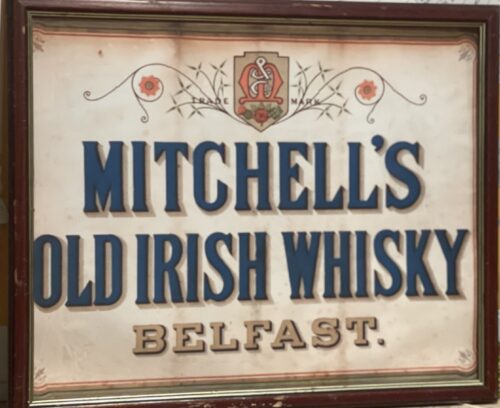 44cm x 65cm Once a giant of the distilling business along with Dunvilles,Mitchell’s fall from grace, like so many other superb Irish distilleries was symptomatic of the economic climate and circumstances of the time. Charles William Mitchell originated from Scotland and took over his fathers distillery in the Campletown area .In the 1860s he moved to Belfast and became manager of Dunvilles Whiskey before establishing his own brand Mitchell & Co tomb St in the late 1860s.A newspaper report in 1895 hailed the virtues of Mitchells Cruiskeen Lawn Whisky,which secured prizes around the world including first place at the New Orleans Exposition.It was a rare Mitchells Cruiskeen Lawn Whiskey mirror that recently commanded £11500 at auction in 2018 following the sale of the contents of an old Donegal public house. Indeed Mitchell’s were renowned for advertising their products on mirrors, trade cards, minature atlas books and pottery to name just a few. Below is the original mirror that was commissioned for their Tomb Street premises on the launch of their Cruiskeen Lawn Old Irish Whisky, late 1800’s. Two were made for the entrance of their Tomb Street premises. Inscribed is the Cruiskeen Lawn poem, with gold leaf barley with green and red in the Mitchell Crest. Definately the holy grail of all mirrors, a true treasure and still survives today in the heart of Belfast and worth the above mentioned princely sum and now probably more !
44cm x 65cm Once a giant of the distilling business along with Dunvilles,Mitchell’s fall from grace, like so many other superb Irish distilleries was symptomatic of the economic climate and circumstances of the time. Charles William Mitchell originated from Scotland and took over his fathers distillery in the Campletown area .In the 1860s he moved to Belfast and became manager of Dunvilles Whiskey before establishing his own brand Mitchell & Co tomb St in the late 1860s.A newspaper report in 1895 hailed the virtues of Mitchells Cruiskeen Lawn Whisky,which secured prizes around the world including first place at the New Orleans Exposition.It was a rare Mitchells Cruiskeen Lawn Whiskey mirror that recently commanded £11500 at auction in 2018 following the sale of the contents of an old Donegal public house. Indeed Mitchell’s were renowned for advertising their products on mirrors, trade cards, minature atlas books and pottery to name just a few. Below is the original mirror that was commissioned for their Tomb Street premises on the launch of their Cruiskeen Lawn Old Irish Whisky, late 1800’s. Two were made for the entrance of their Tomb Street premises. Inscribed is the Cruiskeen Lawn poem, with gold leaf barley with green and red in the Mitchell Crest. Definately the holy grail of all mirrors, a true treasure and still survives today in the heart of Belfast and worth the above mentioned princely sum and now probably more ! -
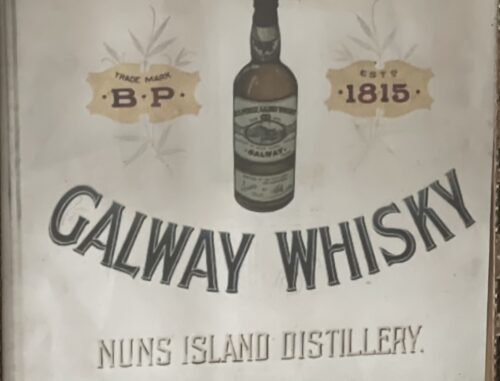
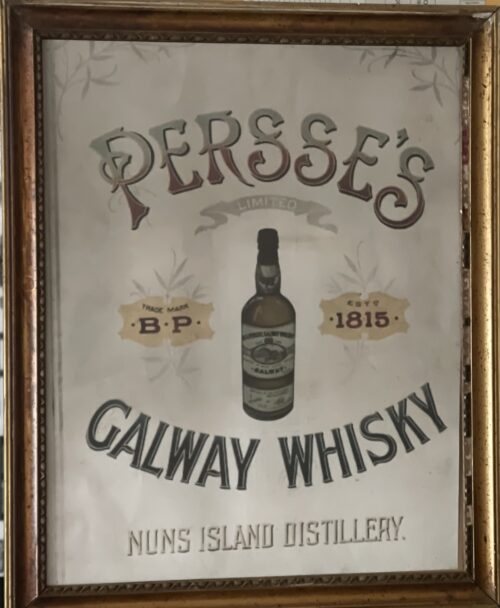 65cm x 45cm Nun's Island Distillery was an Irish whiskey distillery which operated in Galway, Ireland, from at least 1815, and possibly as early as the late 1700s, until circa 1908. At its peak, in the late 1800s, output at the distillery reached 400,000 gallons per annum, and with a workforce of over 100, the distillery was one of the largest local employers. Owned by the Persse family from the 1840s onwards, the distillery produced single pot still whiskey known as Persse's Galway Whiskey. The whiskey was sold locally in Connacht, where for much of the 1800s, Nun's Island was the only licensed distillery.However, it was also exported, and is said to have been a sold to the British House of Commons, a fact proudly noted on their labels. Production at the distillery ceased circa 1908, with the remaining stocks wound down off over several few years. A bottle of Persse's whiskey was placed for auction in 2002 with a reserve price of £100,000 - however, it failed to sell. The bottle later sold for £3,300 in 2014.
65cm x 45cm Nun's Island Distillery was an Irish whiskey distillery which operated in Galway, Ireland, from at least 1815, and possibly as early as the late 1700s, until circa 1908. At its peak, in the late 1800s, output at the distillery reached 400,000 gallons per annum, and with a workforce of over 100, the distillery was one of the largest local employers. Owned by the Persse family from the 1840s onwards, the distillery produced single pot still whiskey known as Persse's Galway Whiskey. The whiskey was sold locally in Connacht, where for much of the 1800s, Nun's Island was the only licensed distillery.However, it was also exported, and is said to have been a sold to the British House of Commons, a fact proudly noted on their labels. Production at the distillery ceased circa 1908, with the remaining stocks wound down off over several few years. A bottle of Persse's whiskey was placed for auction in 2002 with a reserve price of £100,000 - however, it failed to sell. The bottle later sold for £3,300 in 2014.History
The early history of the distillery is somewhat difficult to piece together.It is known that a distillery on Nun's Island was being operated on by a John Joyce in the late 1700s.This distillery, which was subsequently taken over by Patrick Joyce, is thought to have ceased operations in 1807. A Patrick Joyce is recorded as running a small distillery on Nun's Island again in 1823. Therefore, it is possible that the closure was temporary. By 1828, output at the distillery had increased to 130,000 proof gallons per annum. There are claims that the distillery ceased operations again in the late 1830s.However, a newspaper advertisement from 1841 reports that a distillery "lately occupied and worked" by Messrs. James and Patrick Joyce was to be sold on 4 February 1841. The advertisement noted that the distillery was held under a 300-year lease, which had commenced in August 1815.This tallies with Alfred Barnard's 1887 report that Joyce's owned the distillery from 1815 to 1840. In about 1840 or 1841, the distillery was purchased by the Persses, a local family who ran several other distilleries in the area.There is some conflicting information with regard to the precise and nature of the sale date. Barnard reported that the distillery was sold by the Encumbered Claims Courts in 1840.However, a newspaper article from the era reports that the distillery was to be sold by private contract in February 1841. As Barnard mentions that the Persses enlarged the original operation, the confusion may be due to piecemeal purchases of different sections of the site, or delays in finalising the sale as the distillery had been repeatedly advertised for sale beginning in at least early 1840. Initially the Persses converted the distillery to a woollen mill, which was known for producing excellent friezes. However, when their lease on the nearby Newcastle Distillery expired in 1846, they moved their distilling operations at the Nun's Island complex, and re-established the site as a distillery. In 1886, the distillery was visited by British historian Alfred Barnard, as recounted in his seminal publication "The Whiskey Distilleries of the United Kingdom". Barnard noted that at the time of his visit Nun's Island was the sole distillery operating in Connacht, and had an output of about 400,000 gallons per annum. In addition to offices, workshops, stables, and storehouses, the distillery buildings included two lofty Maltings and Corn stores built of stone, five storeys of which were devoted to the storing of corn, and two to malting purposes; an elegant brew house equal to any in Ireland; a back house containing thirteen washbacks, each with a capacity of about 18,000 gallons; a still house containing a 16,000 gallon wash still, a 10,000 gallon spirit still, and a 6,000 gallon low-wines still; a spirit store occupied by a 12,000 gallon vat; and five warehouses, holding a total of about 5,000 casks at the time. Like many other Irish distilleries, Nun's Island encountered financial difficulties during the early part of the 20th Century, is thought to have closed shortly before World War I. Since closing, some of the distillery complex has been demolished. However, several of the main distillery buildings, notably the large riverside warehouse, are still extant. -
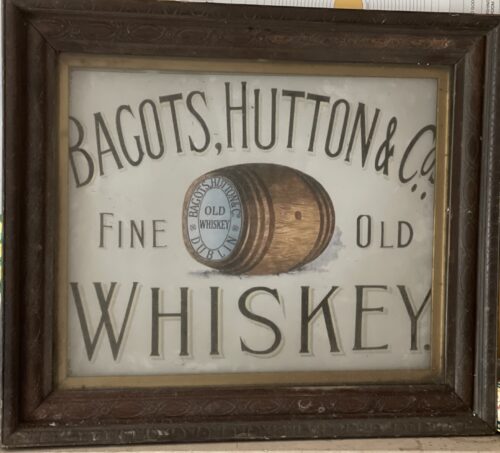
 68cm x 56cmWith a history dating back generations it is inevitable that many myths and legends about Kinahans whiskey steeped into storytelling. But the origins of the L.L. mark have been well documented. In 1807, the Lord Lieutenant of Ireland (the head of state), Charles Lennox, was so impressed with the whiskeys made by Kinahans that he ordered all stocks at the Kinahans Dublin vaults to be taken exclusively for his private use, marking each cask with “L.L.”. The news, which were highly advertised, led to Kinahans becoming one of the most sought after whiskeys both, domestically and in neighbouring countries.In 1819, the popularity of the Kinahans brand allowed to set up its own four story headquarters, at the corner of Burgh Quay and D’Olier Street, Dublin, Named the Carlisle Building, to resonate with nearby Carlisle Bridge, the premises were built as part of the re-development of the city being overseen by the city's Wide Street Commissioners. By the middle of 20th Century the historic building has been taken down.As Kinahans popularity grew, London became a natural base for the company in 1800s wishing to expand into international markets. On 31 December 1841, Kinahans appointed Mr. George Smyth as its first agent in the city of London, with an address at no.1 White Hart Court, London, UK. For over half a century the company's London base has formed the centre of a great volume of export trade to the Continent, China, India, Australia and all the foreign markets.
68cm x 56cmWith a history dating back generations it is inevitable that many myths and legends about Kinahans whiskey steeped into storytelling. But the origins of the L.L. mark have been well documented. In 1807, the Lord Lieutenant of Ireland (the head of state), Charles Lennox, was so impressed with the whiskeys made by Kinahans that he ordered all stocks at the Kinahans Dublin vaults to be taken exclusively for his private use, marking each cask with “L.L.”. The news, which were highly advertised, led to Kinahans becoming one of the most sought after whiskeys both, domestically and in neighbouring countries.In 1819, the popularity of the Kinahans brand allowed to set up its own four story headquarters, at the corner of Burgh Quay and D’Olier Street, Dublin, Named the Carlisle Building, to resonate with nearby Carlisle Bridge, the premises were built as part of the re-development of the city being overseen by the city's Wide Street Commissioners. By the middle of 20th Century the historic building has been taken down.As Kinahans popularity grew, London became a natural base for the company in 1800s wishing to expand into international markets. On 31 December 1841, Kinahans appointed Mr. George Smyth as its first agent in the city of London, with an address at no.1 White Hart Court, London, UK. For over half a century the company's London base has formed the centre of a great volume of export trade to the Continent, China, India, Australia and all the foreign markets.
The Royal Warrants

1845
Throughout 1800s Kinahans continued to offer the highest level of differentiated taste and craftsmanship, for which Queen Victoria awarded it a Royal Warrant in 1845. With major accolades in hand, the recruitment of the agents and retail outlets continued.
The Preferred Whiskey Of Jerry Thomas

1862
With popularity in the British Isles, by the middle of 19th century Kinahans whiskey came to be the notice of many American authors and connoisseurs. In 1860s Kinahans came to the attention of the legendary Jerry Thomas. Also known as "the father of American mixology", Jerry Thomas was a revolutionary character, who due to his creativity and showmanship transformed the image of the bartender as a creative professional. In his 1862 "Guide on How to Mix Drinks", Jerry Thomas featured Kinahans in one of his book's recipes. The Bartender's "Guide on How to Mix Drinks" was the first drinks and mixology book ever published in the United States and can be counted amongst very few most influential drinks publications to date.
Protected Trademark

1863
Since its rise to popularity Kinahans faced hazardous times. Because of the brand's accolades, unscrupulous merchants publicans and others were restless in using the Kinahans bottles, labels and brand marks in order to sell their own products. In 1863, the activities of William Bolton, a grocer in Dublin's Westmoreland Street, led to the final and landmark case of legal redress. In the Irish case of Kinahan v. Bolton, the Irish Courts granted an injunction to restrain others from invading the Kinahans L.L. mark.
A Household Name

1881
The terms “Kinahans” and “Kinahans L.L.” is by 1881 a household name, becoming widely accepted as shorthand for a whisky of a specific price, quality and reputation. Confirmation for this is found in the 1881 Edition of Brewer's Dictionary of Phrases and Fables, in which the origin of L.L. trademark is also described. It is against this background that familiarity with the Kinahans brand name found expression in books written by countless British and American authors.
Decline Of The Irish Whiskey Industry
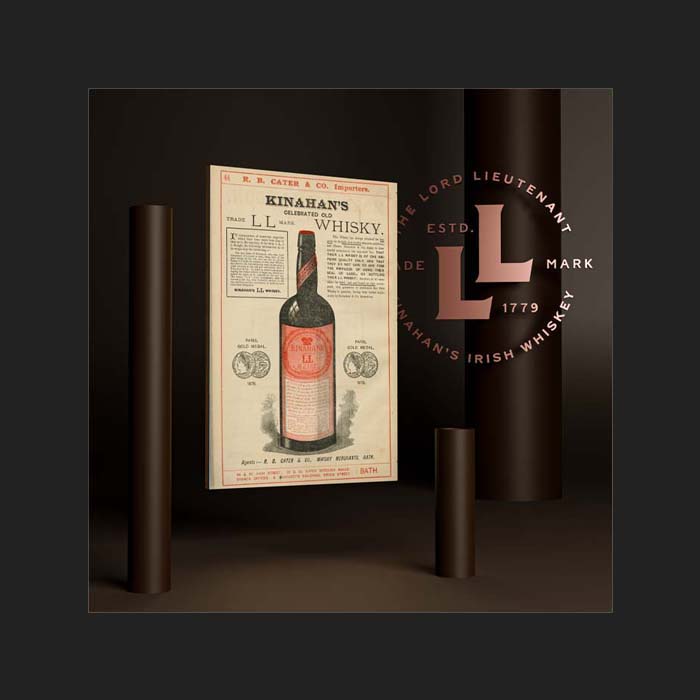
1902-1911
The new century began favourably. However, nothing could shield the company from the tribulations that were about to unfold. One of the key family members, George Kinahan died in 1903 and with him ended the family's long association with Dublin civic life as well as the prestige and opportunities which would have created. As the longest serving director, he took with him an intimate knowledge of the company's history as well as a wealth of practical business experience. Additionally, his long directorship at the Bank of Ireland would also have been of great practical value, not least because at various times his fellow directors at the bank included senior members of the Jameson whiskey family. On top of the departure of George Kinahan, the company had to cope with changing and more difficult economy in Ireland. Overall Irish whiskey exports declined spectacularly between 1900 and 1914. In Ireland itself both consumption and production fell, aided by increase of almost a third in spirit duty, as proposed by Lloyd George in his 1909 budget.
Transfer Of The Brand
 In June 1911 Kinahans business operations were being transferred to Bagot & Hutton, another long established Dublin wine and spirit enterprise. This company bottled and distributed Kinahans L.L. whiskey up until the time of Prohibition in the United States in 1920.In November 1920, following the Prohibition in the United States, an economic decline and a forthcoming Civil War in Ireland, the two spirit houses combined and were registered as Bagot Hutton & Kinahan. This arrangement continued until October 1988, when the shareholders decided to take a long break for one of Dublin's most prominent business houses, until better times.
In June 1911 Kinahans business operations were being transferred to Bagot & Hutton, another long established Dublin wine and spirit enterprise. This company bottled and distributed Kinahans L.L. whiskey up until the time of Prohibition in the United States in 1920.In November 1920, following the Prohibition in the United States, an economic decline and a forthcoming Civil War in Ireland, the two spirit houses combined and were registered as Bagot Hutton & Kinahan. This arrangement continued until October 1988, when the shareholders decided to take a long break for one of Dublin's most prominent business houses, until better times. -
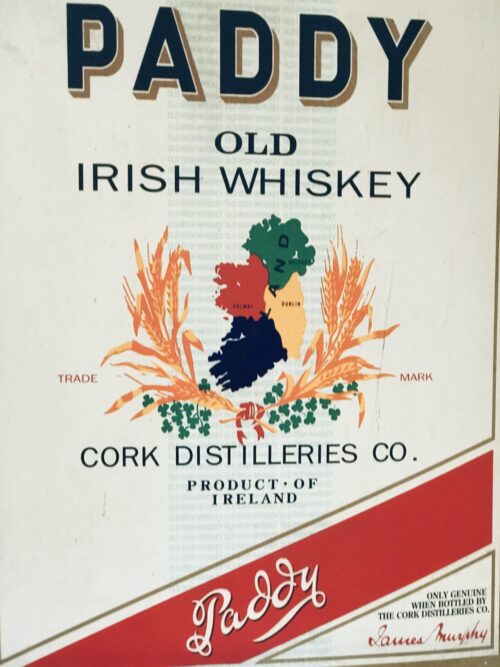
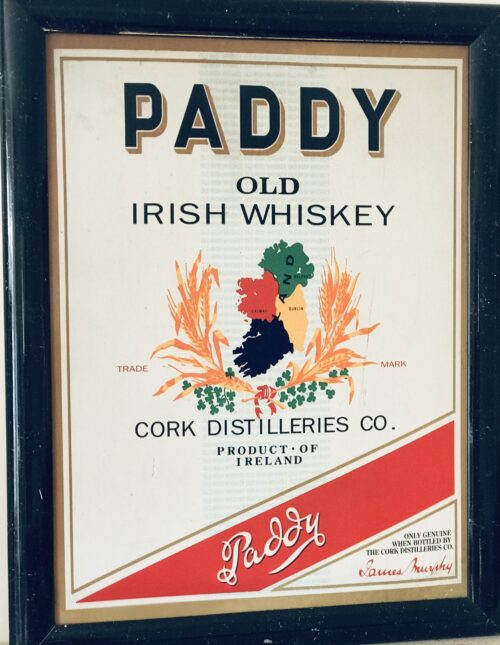 Nice,framed Paddy Old Irish Whiskey Advert Blarney Co Cork 75cm x 50cm The Cork Distilleries Company was founded in 1867 to merge four existing distilleries in Cork city (the North Mall, the Green, Watercourse Road, and Daly's) under the control of one group.A fifth distillery, the Midleton distillery, joined the group soon after in 1868. In 1882, the company hired a young Corkman called Paddy Flaherty as a salesman. Flaherty travelled the pubs of Cork marketing the company's unwieldy named "Cork Distilleries Company Old Irish Whiskey". His sales techniques (which including free rounds of drinks for customers) were so good, that when publicans ran low on stock they would write the distillery to reorder cases of "Paddy Flaherty's whiskey". In 1912, with his name having become synonymous with the whiskey, the distillery officially renamed the whiskey Paddy Irish Whiskey in his honour. In 1920s and 1930s in Ireland, whiskey was sold in casks from the distillery to wholesalers, who would in turn sell it on to publicans. To prevent fluctuations in quality due to middlemen diluting their casks, Cork Distilleries Company decided to bottle their own whiskey known as Paddy, becoming one of the first to do so
Nice,framed Paddy Old Irish Whiskey Advert Blarney Co Cork 75cm x 50cm The Cork Distilleries Company was founded in 1867 to merge four existing distilleries in Cork city (the North Mall, the Green, Watercourse Road, and Daly's) under the control of one group.A fifth distillery, the Midleton distillery, joined the group soon after in 1868. In 1882, the company hired a young Corkman called Paddy Flaherty as a salesman. Flaherty travelled the pubs of Cork marketing the company's unwieldy named "Cork Distilleries Company Old Irish Whiskey". His sales techniques (which including free rounds of drinks for customers) were so good, that when publicans ran low on stock they would write the distillery to reorder cases of "Paddy Flaherty's whiskey". In 1912, with his name having become synonymous with the whiskey, the distillery officially renamed the whiskey Paddy Irish Whiskey in his honour. In 1920s and 1930s in Ireland, whiskey was sold in casks from the distillery to wholesalers, who would in turn sell it on to publicans. To prevent fluctuations in quality due to middlemen diluting their casks, Cork Distilleries Company decided to bottle their own whiskey known as Paddy, becoming one of the first to do so -

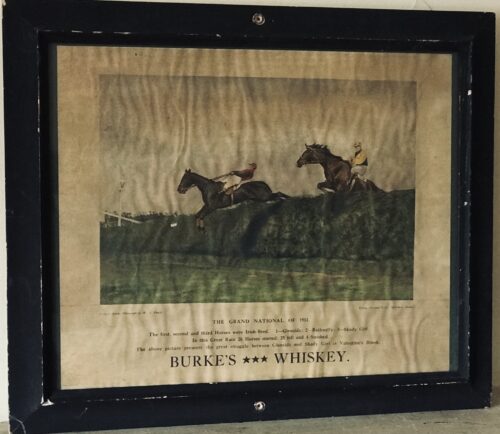 Another extremely rare and quite ancient advertising print from 1911 depicting the Aintree Grand National of that year when Burkes Whiskey Ltd celebrated the fact that the first 3 horses home were all Irish Bred;1-Glenside,2-Rathnally,3- Shady Girl.The actual image taken by the photographer W.A Rouch shows an almighty tussle at the famous Valentines Brook fence between Shady Girl and Glenside.Despite their valiant attempts to market their business Burkes Three Star Irish Whiskey,another once famous distillery also became sadly defunct a few short years later. Mullingar Co. Westmeath 37cm x 44cm
Another extremely rare and quite ancient advertising print from 1911 depicting the Aintree Grand National of that year when Burkes Whiskey Ltd celebrated the fact that the first 3 horses home were all Irish Bred;1-Glenside,2-Rathnally,3- Shady Girl.The actual image taken by the photographer W.A Rouch shows an almighty tussle at the famous Valentines Brook fence between Shady Girl and Glenside.Despite their valiant attempts to market their business Burkes Three Star Irish Whiskey,another once famous distillery also became sadly defunct a few short years later. Mullingar Co. Westmeath 37cm x 44cm -
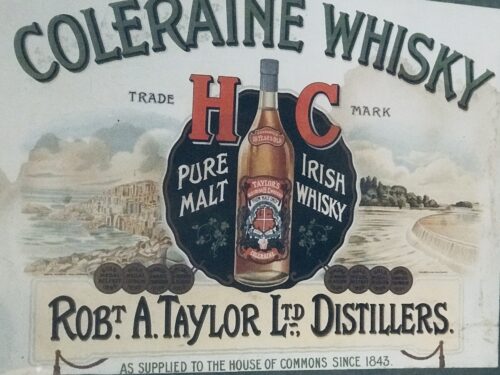
 65cm x 48cm. Belfast Coleraine Whiskey( Robt A Taylor Distillers) framed advertising print, proudly displaying the various medals won by the company at trade fairs over the years.The original Coleraine distillery,which opened in 1820 was one of the two malt distilleries on the island of Ireland by then.It closed its doors in 1978 as part of a rationalisation process by its owner at the time, the mighty Bushmills.It was always a small distillery and has been later described as a "slightly haphazard" operation but still managed to acquire a prestigious contract to supply the House of Commons 1843 ,such was the quality and meticulous preparation of its malt, none of which was ever bottled under 10 years old.This magnificent original print proudly makes mention of its association with the Parliament in London-and also depicts the beautiful scenes of the Giants Causeway and the Salmon Leap,both near Coleraine.
65cm x 48cm. Belfast Coleraine Whiskey( Robt A Taylor Distillers) framed advertising print, proudly displaying the various medals won by the company at trade fairs over the years.The original Coleraine distillery,which opened in 1820 was one of the two malt distilleries on the island of Ireland by then.It closed its doors in 1978 as part of a rationalisation process by its owner at the time, the mighty Bushmills.It was always a small distillery and has been later described as a "slightly haphazard" operation but still managed to acquire a prestigious contract to supply the House of Commons 1843 ,such was the quality and meticulous preparation of its malt, none of which was ever bottled under 10 years old.This magnificent original print proudly makes mention of its association with the Parliament in London-and also depicts the beautiful scenes of the Giants Causeway and the Salmon Leap,both near Coleraine. -
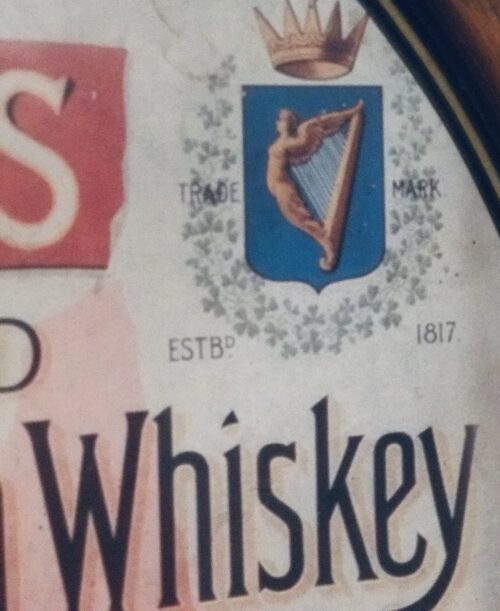
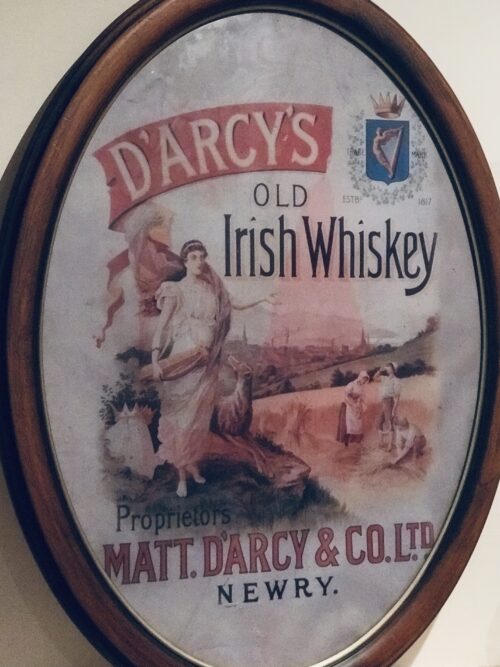 Newry Co Down 80cm x 57cm D'arcys of Newry Co Down were yet another example of a once thriving Irish whiskey distillery now sadly gone to the wayside despite the massive recent resurgence of the product.During one point in the late 1800s and early 1900s it seemed every town and village in Ireland had its own distillery as well as the obvious major commercial centres of Dublin,Belfast,Cork and Limerick.However that trend is now being reversed with the news this year that plans are afoot to reopen the old distillery in Newry and kick-start the rebirth of Matthew D'Arcy & Co .This charming print depicting a peaceful pastoral scene was used extensively by D'Arcys before its closure in the early part of the 20th century.
Newry Co Down 80cm x 57cm D'arcys of Newry Co Down were yet another example of a once thriving Irish whiskey distillery now sadly gone to the wayside despite the massive recent resurgence of the product.During one point in the late 1800s and early 1900s it seemed every town and village in Ireland had its own distillery as well as the obvious major commercial centres of Dublin,Belfast,Cork and Limerick.However that trend is now being reversed with the news this year that plans are afoot to reopen the old distillery in Newry and kick-start the rebirth of Matthew D'Arcy & Co .This charming print depicting a peaceful pastoral scene was used extensively by D'Arcys before its closure in the early part of the 20th century. -
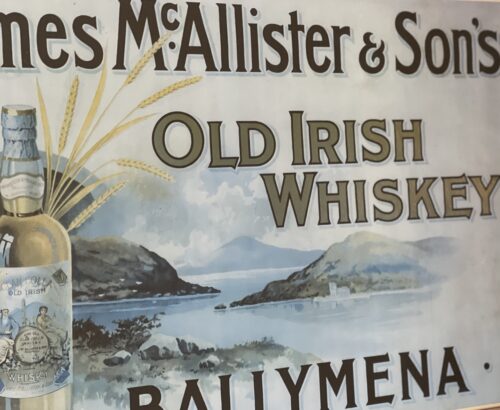
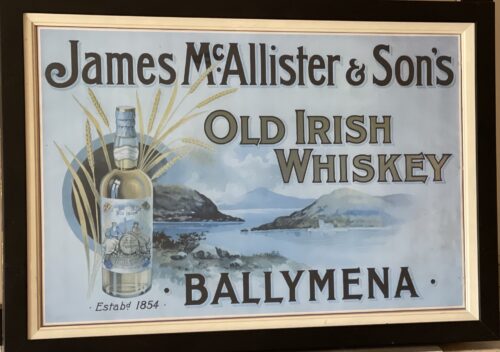 Ballyclare Co Antrim. 50cm x 67cm James McAllister & Sons,Ballymena was a distillery established in 1854 by an Antrim entrepreneur of the same name.McAllister was very innovative both in terms of developing his range of products and also in its marketing.Long before television, he used advertising from the use of mirrors displayed in pubs to posters like this particular one placed at prominent locations, in order to attract potential customers.Among his stable of whiskey brands, the most famous was "Clan Colla" which, unusually for a local distiller, was widely exported in the early 1900s to the US and the rest of the world.
Ballyclare Co Antrim. 50cm x 67cm James McAllister & Sons,Ballymena was a distillery established in 1854 by an Antrim entrepreneur of the same name.McAllister was very innovative both in terms of developing his range of products and also in its marketing.Long before television, he used advertising from the use of mirrors displayed in pubs to posters like this particular one placed at prominent locations, in order to attract potential customers.Among his stable of whiskey brands, the most famous was "Clan Colla" which, unusually for a local distiller, was widely exported in the early 1900s to the US and the rest of the world.

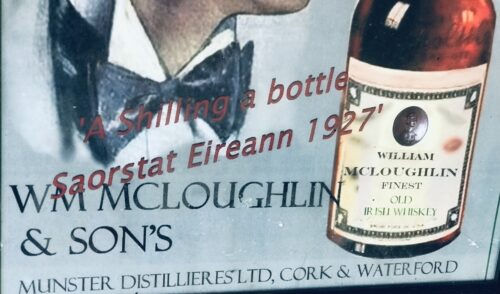
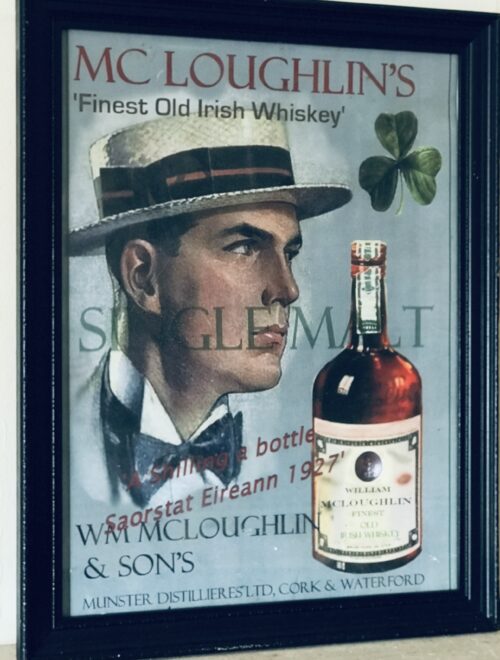

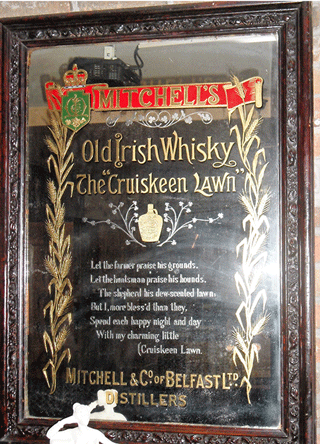 Some original and rare Mitchell mirrors are still surviving today and can be found in some pubs in and around Belfast today
Some original and rare Mitchell mirrors are still surviving today and can be found in some pubs in and around Belfast today
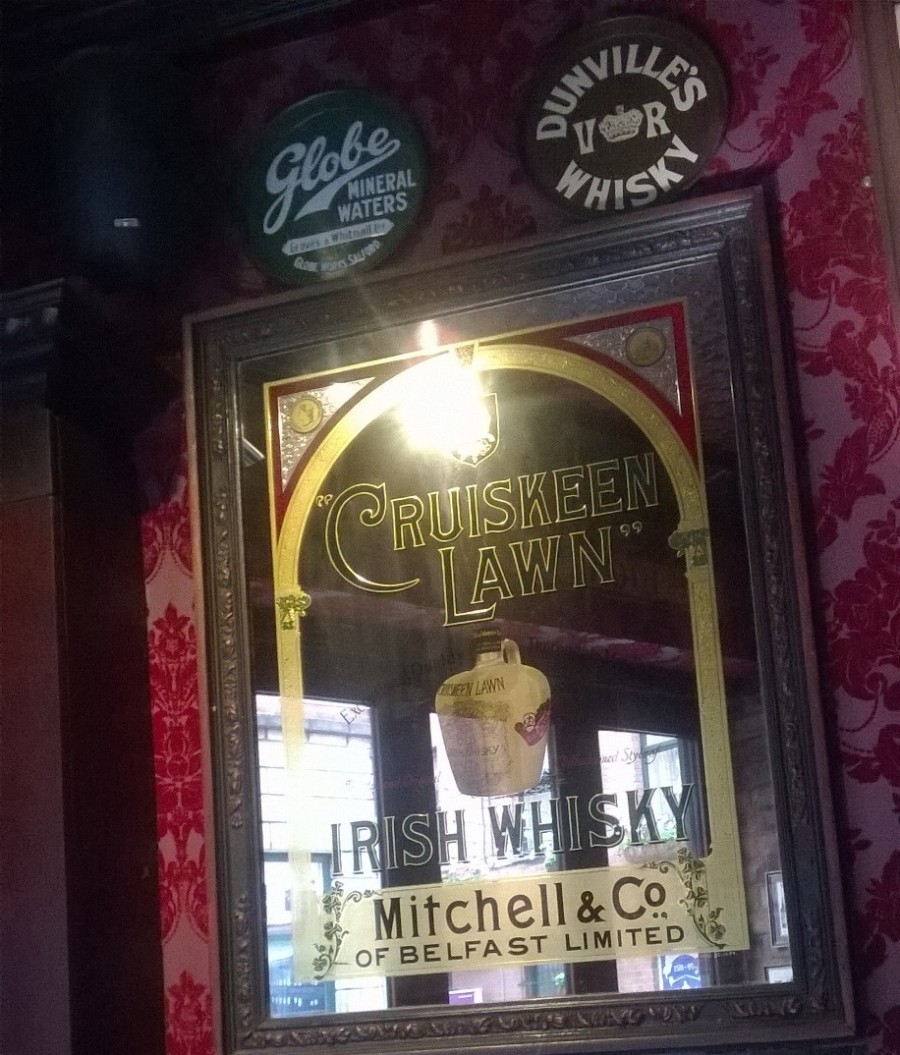 Some other examples of Mitchell Mirrors which were mass produced for advertising their products
Some other examples of Mitchell Mirrors which were mass produced for advertising their products

